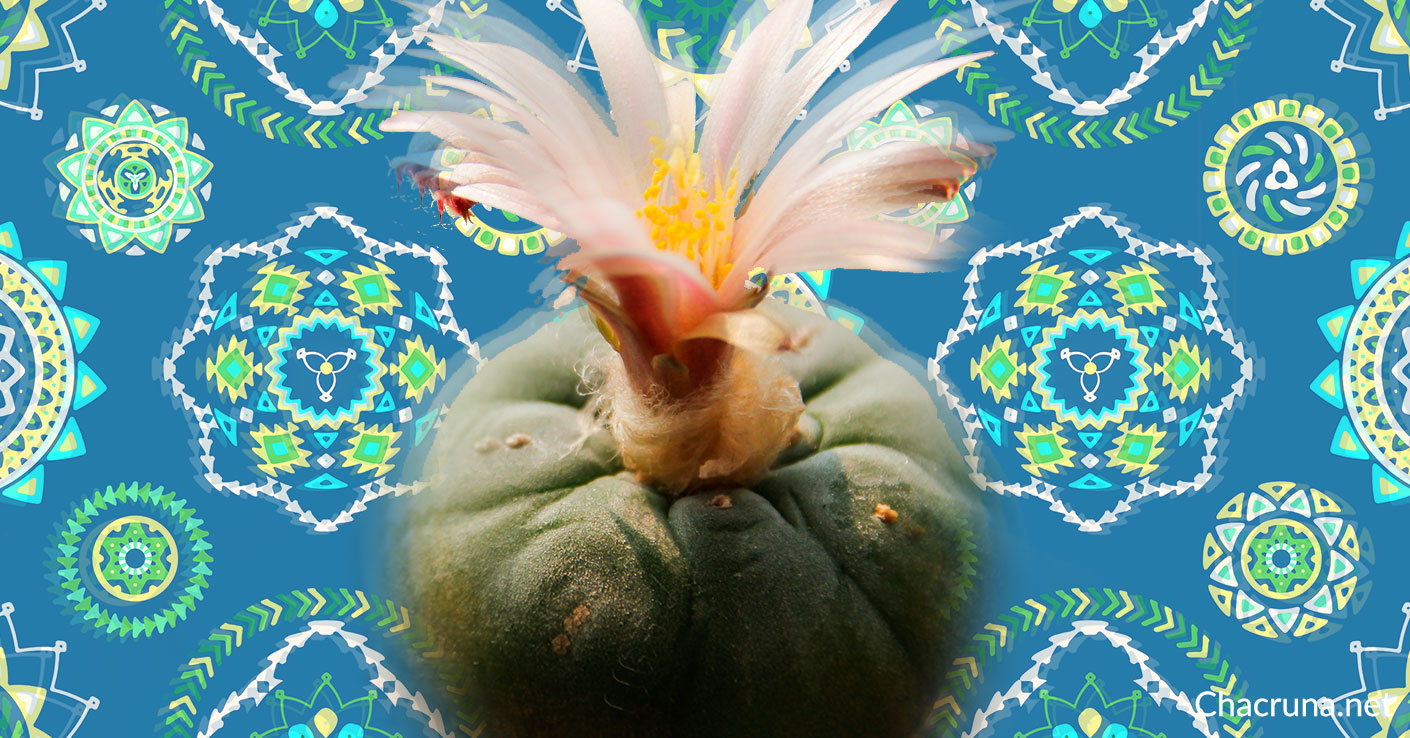- Mrs. Amada Cardenas: Keeper of the Peyote Gardens - November 20, 2019
- Peyote: Plant Medicine for the Body, Mind and Soul - April 18, 2017
Peyote (Lophophora williamsii) is a small, spineless, mind-altering cactus that, for centuries, has been terribly misunderstood by Western society. It grows naturally in the desert thorn scrub landscape along the Texas border with Mexico down into north-central Mexico and has been used by indigenous peoples for millennia. This unassuming cactus has in the past been vilified by Spanish Catholic priests in the sixteenth –nineteenth centuries and in the twentieth century by Protestant clergy who claimed it to be the “root of the devil.” Even the United States Government considers peyote dangerous and has classified it as a Schedule I drug, along with heroin, cocaine, methamphetamine, and hard narcotics. The reason given for this classification is that one of its 60-plus alkaloids, naturally occurring chemicals, mescaline, is known to bring on bright vivid geometric patterned visions. Yet, indigenous peoples today, such as the Huichol Indians of Mexico and members of many tribes in the United States and Canada who belong to the Native American Church (NAC), understand peyote as a sacred plant that helps one talk to God and follow a good life path. It is also known among peyote-wise people to be a medicine for the body and soul. Let’s take a look at the history of peyote in the lives of indigenous peoples and how this sacred succulent has changed the perceptions of Western people who have studied peyote, consumed it, and listened to the knowledge it has to teach.
We know that humans have held peyote in high esteem since ancient times. Prehistoric rock art in northern Mexico and West Texas is believed to portray peyote plants and presumably shamans or gods in dramatic poses.1 Necklaces of dried peyote, strung beadlike on fiber, have been found in rock shelters and cave burials that date to 6,000 BCE.2 Peyote appears to have been sought out as a special trade item prized for its vision-producing qualities, and was transported south to the Valley of Mexico and as far north as New Mexico.3
In the past, a number of indigenous tribes in Mexico consumed peyote in their rituals and ceremonies to commune with the all-encompassing spirit world. In contemporary times the Huichol Indians living in the Sierra Madre Mountains of western Mexico are the only indigenous culture to maintain their ancient peyote traditions and pass them on to the younger generations. Groups of Huichols annually make an arduous pilgrimage to the sacred peyote desert in the State of San Luis Potosi to leave offerings, harvest peyote, and commune with nature in all of her glory as a reflection of their gods. One Huichol shaman explained it this way: “Peyote is everything; it is the crossing of the souls; it is everything that is. Without peyote, nothing would exist.”4
Indigenous people in the United States west of the Mississippi River who survived the arrival of the Spaniards and the early American settlers were displaced from their homelands. Comanche, Lipan Apaches, and others fled far south along the border of Texas and Coahuila, Mexico. There they encountered Indians from these peyote regions and were introduced to the powerful relationships one can have with this plant. When the last of these free-roaming Native Americans were sent to reservations in Oklahoma, they also brought their peyote knowledge with them and shared it with others within a framework for understanding the religious meaning surrounding its consumption. In efforts to assimilate Native Americans into the “White man’s world,” Catholic and Protestant missionaries tried forcefully to eradicate the use of peyote on the reservations. Native Americans resisted these forces by ingeniously integrating peyote beliefs and practices with Christian doctrine that was impressed upon them. The Native American Church arose from this blending of religions. Founded in 1918, it is recognized by the federal government as a bona fide religion. Members of the NAC understand peyote as a medicine and consume it as a holy sacrament. One Cheyenne Arapaho man explained: “Through… this peyote I was made well… I could see that there was something greater than this medicine itself. I saw that God… planted this herb and blessed it, and I am going to take God’s blessing.”5
In the Western world, people of European descent learned of peyote first through contact with indigenous people and their peyote religions, and later through local Mexicans in the region where peyote grows who had became familiar with its medicinal properties. In the late 1800s, scientists such as pharmacologist Louis Lewin received dried peyote to study from the U.S. pharmaceutical company of Parke, Davis, and Company. From his research, he created a classification system for psychoactive plants; he put peyote under the category Phantastica, which was also the title of his book on this subject. Arthur Heffter, who conducted self-experiments with the plant, was the first to isolate and identify mescaline in peyote.6 In 1891, anthropologist James Mooney was most likely the first non-Indian to participate in a peyote ceremony. Ethnobotanist Richard Evans Schultes began his illustrious career in the early 1930s advancing knowledge on psychoactive plants with his peyote research. Mooney and Schultes would later testify before courts of law in support of the benefits peyote and the peyote religion have for Native Americans.7
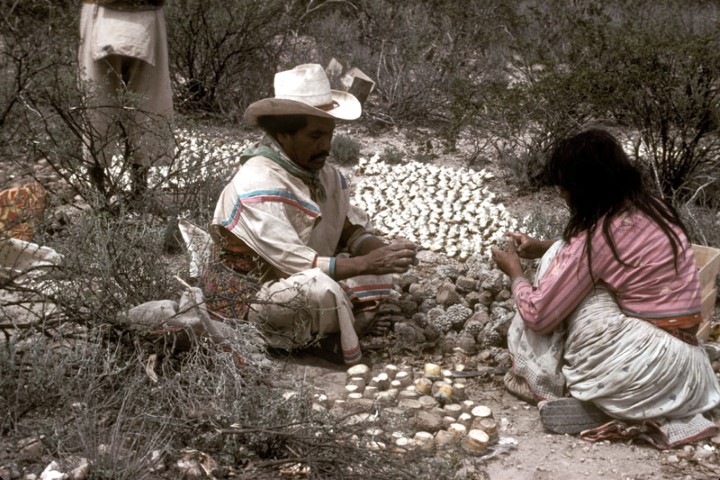
– Image: Stacy Schaefer. Huichols drying peyote

– Image: Stacy Schaefer. Peyote, Yarn Painting by Mariano Valadez

– Image: Stacy Schaefer. Peyote from Wirikuta in Huichol votive bowls
Peyote made its way into the lives of poets, writers, musicians and artists.from the 1950s to the 1970s. Many were deeply inspired by this green-grey cactus and its mescaline alkaloid; for some it was their first “psychedelic” experience. Aldous Huxley wrote The Doors of Perception after a profound mescaline-fueled experience. Jim Morrison, of the rock group The Doors, named his band after Huxley’s book; he is reported to have occasionally consumed peyote. Under the influence of peyote while working the night shift at a psychiatric ward, Author Ken Kesey, developed the Indian Character Chief Broom in his book One Flew Over the Cuckoo’s Nest.8 Comedian George Carlin related how peyote and LSD had transformed his life by saying: “I’m quite sure that my use of acid and peyote helped me accept what was really going on inside of me instead of what I had imposed on myself”.9 Eventually peyote, mescaline, LSD. and other psychedelic substances became more easily accessible outside of laboratory settings and for many were synonymous with the counter-culture movement of the 1960s.
Angry and alarmed by the potential “danger” these mind-altering substances may have on individuals and on society, the mainstream establishment rallied to dismantle the movement. One principle strategy was to eliminate access to all psychedelic substances. The U.S. government quickly outlawed their use with the institution of The Controlled Substances Act of 1970 (part of the Comprehensive Drug Abuse Prevention and Control Act of 1970). Peyote was included in drugs classified as Schedule 1, which are considered to have “high potential for abuse” and serve no “accepted medical use in treatment”10 Fortunately a clause was added to this legislation that exempts Native American Church members who use peyote for religious purposes.11 The challenges to reclassify peyote so that it is legally accessible to others who are not members of the Native American Church are formidable. Legislation permitting the religious use of the vision-producing brew of ayahuasca (Bannisteriopsis caapi with other plant admixtures) may set a strong precedent for greater inclusion of additional individuals in future changes to the current peyote laws.12
Medical research over the decades overwhelmingly points to the therapeutic value of peyote, something that indigenous people have known for years. Alkaloids in peyote have analgesic and antibiotic properties beneficial to healing the human body.13
More research is greatly needed to better understand the ways in which the multitude of alkaloids in peyote interact with the human body and with each other. Peyote and its consumption in Native American Church meetings have helped a number of individuals recover from alcohol and other drug addictions. As a religious sacrament, peyote has also helped individuals recognize and resolve personal problems.14 And one should not overlook the powerful experiences that can occur from ingestion of peyote that may lead individuals to greater spiritual awareness and meaning in their lives.
The greatest peril to peyote in the twenty-first century is its scarcity and potentially endangered status. Peyote populations are being dramatically decimated in Mexico and Texas due to loss of natural habitat and overharvesting. In south Texas, local Mexican Americans reported that, in the past, one could see peyote growing for miles as thick as plush carpet.15 Nowadays, it is increasingly difficult for peyote distributors legally recognized by the federal government to find and harvest peyote to sell to members of the Native American Church. Fences that enclose large ranches containing the majority of peyote are gated and locked, making access essentially impossible for distributors, unless they have secured a lease. Government-sponsored programs to radically alter the land for cattle grazing rely on root plows to transform the terrain. Peyote, along with all the surrounding vegetation, is ripped out by the roots and discarded.16 A similar fate impacts the peyote desert of north-central Mexico with commercial development and land-seeking farmers who are attempting to transform parts of this desert into arable land to grow crops. The demand for peyote far exceeds the number of plants accessible for sustainable harvesting. Membership in the Native American Church has undoubtedly far exceeded the 250,000 reported in 1996.17 The annual number of peyote “buttons” sold in the last 20 years as reported by peyote distributors to the Texas Department of Safety range from 1,106,209–2,258,993.18 In the peyote desert located in San Luis Potosí, Mexico, an infamous black market of indiscriminately harvested peyote threatens the health of the last stands of peyote populations visited over the centuries by Huichol pilgrims. New Age psychedelic tourism has also taken its toll on the viability of this sacred plant for Huichol people.19
How can this devastating situation be turned around? For some, the answer lies in establishing preserves to protect peyote populations and cultivate peyote through seed propagation and generating plants from harvested ones. In the 1990s, the Peyote Foundation was established in Arizona to “initiate conservation efforts for the peyote cactus.” Unfortunately, the founders of the Peyote Foundation, who are not members of the Native American Church, were also not protected by Arizona or federal laws regarding peyote and its use. Task force officers from the county confiscated more than eleven thousand peyote plants that were growing in the Foundation’s greenhouse.20 The Cactus Conservation in West Texas, founded in the early twenty-first century by biology professor Martin Terry at Sul Ross University, is dedicated to the study and preservation of peyote and other endangered cacti endemic to the area. This foundation’s outreach efforts have engaged Native American Church members concerned with the future of peyote and its accessibility.21
It would be a tragic day if peyote no longer existed in its native habitat. The words of the Huichol shaman who profoundly explained the importance of peyote is worth repeating:
“Peyote is everything; it is the crossing of the souls; it is everything that is. Without peyote, nothing would exist.” Let’s hope that we are not too late to ensure that peyote will continue to grow and thrive into the distant future.22

– Image: Stacy Schaefer. Peyote harvested for sale South Texas
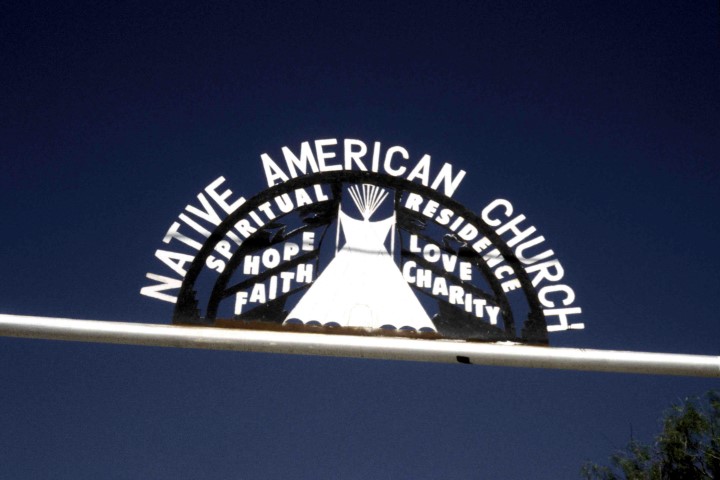
– Image: Stacy Schaefer. Entrance to Mrs. Cardenas’ house South Texas
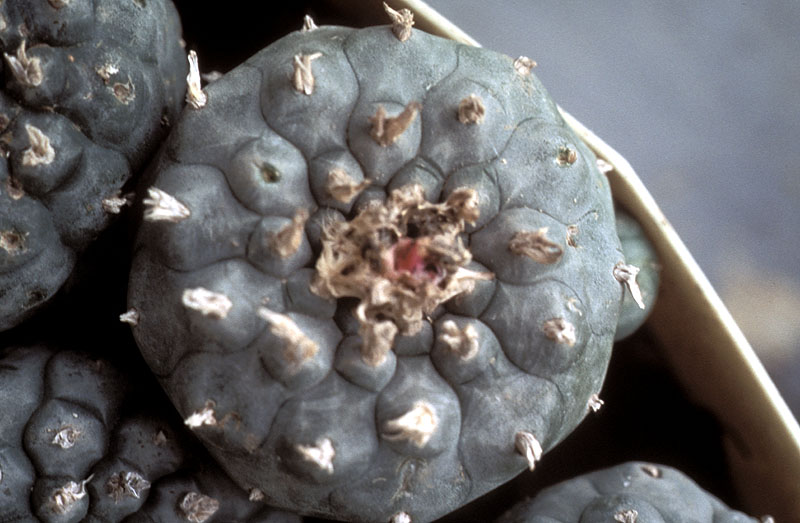
– Image: Stacy Schaefer. Peyote-South Texas
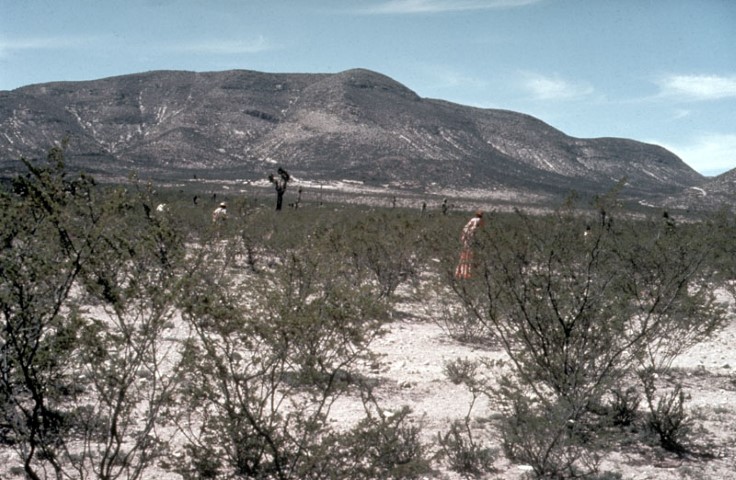
– Image: Stacy Schaefer. Wirikuta Huichols hunting peyote
References
- Boyd, Carolyn E. 2016. The White Shaman Panel: An Enduring Creation Narrative in the Rock Art of the Lower Pecos. Austin: University of Texas Press; Boyd, Carolyn E., and J. Philip Dering 1996 Medicinal and Hallucinogenic Plants Identified in the Sediments and Pictographs of the Lower Pecos, Texas Archaic. Antiquity 70(268):256–275. ↩
- El-Seedi, Hesham R., Peter A. De Smet, Olof Beck, Göran Possnert, and Jan G. Bruhn 2005 Pre-historic Peyote Use: Alkaloid Analysis and Radiocarbon Dating of Archaeological Specimens of Lophophora from Texas. Journal of Ethnopharmacology 101:238–242. ↩
- Weigand, Phil C.1981 Differential Acculturation among the Huichol Indians. In Themes of Indigenous Acculturation in Northwest Mexico. Thomas B. Hinton and Phil C. Weigand, eds. Pp. 9–21. Anthropological Papers 38, Tucson: University of Arizona Press. ↩
- Schaefer, Stacy B. 1996 The Crossing of the Souls: Peyote, Perception and Meaning. In People of the Peyote: Huichol Indian History, Religion and Survival. Stacy B. Schaefer and Peter T. Furst, eds. Pp. 138–168. Albuquerque: University of New Mexico Press. P. 138 ↩
- Stewart, Omer C. 1987 Peyote Religion: A History. Norman: University of Oklahoma Press. P. 107. ↩
- https://www.erowid.org/culture/characters/heffter_arthur/heffter_arthur.shtml accessed March 16, 2017 ↩
- Maroukis, Thomas C. 2010 The Peyote Road: Religious Freedom and the Native American Church. Norman: University of Oklahoma Press. P. 51; Stewart 1987 (ibid) (see 5.) p. 238. ↩
- Wolf, Tom 1968. The Electric Kool-Aid Acid Test. Farrar, Strauss and Giroux. ↩
- George Carlin. (n.d.). AZQuotes.com. Retrieved March 19, 2017, from AZQuotes.com Web site: http://www.azquotes.com/quote/1283862 ↩
- https://en.wikipedia.org/wiki/Controlled_Substances_Act#Schedule_I_controlled_substances (accessed March 18, 2017). ↩
- https://www.deadiversion.usdoj.gov/21cfr/cfr/1307/1307_31.htm accessed March 18, 2017 ↩
- Gonzales vs. O Centro Espirita Beneficente Uniao do Vegetal https://www.supremecourt.gov/opinions/05pdf/04-1084.pdf ↩
- McCleary, James A., Paul S. Sypherd, and David L. Walkington 1960 Antibiotic Activity of an Extract of Peyote (Lophophora williamsii (Lemaire) Coulter), Economic Botany 14(3):247–249.; Schultes, Richard Evans 1938 The Appeal of Peyote (Lophophora williamsii) as Medicine. American Anthropologist 40:698–725. ↩
- Calabrese, Joseph D. 1997 Spiritual Healing and Human Development in the Native American Church: Toward a Cultural Psychiatry of Peyote. Psychoanalytic Review 84(2):237–255.; Calabrese, Joseph D 2001 The Supreme Court Versus Peyote: Consciousness Alteration, Cultural Psychiatry, and the Dilemma of Contemporary Subcultures. Anthropology of Consciousness 12:4–18.; Halpern, John H., A. R. Sewell, James I. Hudson, Deborah Yurgelun-Todd, and Harrison G. Pope Jr. 2005 Psychological and Cognitive Effects of Long-Term Peyote Use Native Americans. Biological Psychiatry 58(8):624–631. ↩
- Schaefer, Stacy B. 2015 Amada’s Blessings from the Peyote Gardens of South Texas. Albuquerque: University of New Mexico Press. ↩
- Morgan, George 1983 Hispano-Indian Trade of an Indian Ceremonial Plant, Peyote (Lophophora williamsii), on the Mustang Plains of Texas. Journal of Ethnopharmacology 9:319–321; Anderson, Edward 1995 The “Peyote Gardens of South Texas: a Conservation Crisis? Cactus and Succulent Journal 67(2):67-73; Trout http://troutsnotes.com/peyote-crisis-revisited/accessed March 20, 2017 ↩
- Anderson, Edward 1996 Peyote: The Divine Cactus. Tucson: University of Arizona Press. ↩
- Schaefer 2015 (ibid see 15. pp. 249-250) ↩
- Furst, Peter T. and Stacy B. Schaefer 1996 Peyote Pilgrims and Don Juan Seekers: Huichol Indians in a Multicultural World . In People of the Peyote: Huichol Indian History, Religion and Survival. Stacy B. Schaefer and Peter T. Furst, eds pp. 503-521 ↩
- Schaefer 2015 p. 271 ↩
- http://www.cactusconservation.org/CCI/CCI_Home.html accessed March 18, 2017 ↩
- Please see Peyote: History, Tradition, Politics and Conservation by Labate and Cavnar eds. (2016). It is the most current comprehensive publication on peyote and the many aspects of this revered cactus. ↩
Take a minute to browse our stock:
Did you enjoy reading this article?
Please support Chacruna's work by donating to us. We are an independent organization and we offer free education and advocacy for psychedelic plant medicines. We are a team of dedicated volunteers!
Can you help Chacruna advance cultural understanding around these substances?
Become a Chacruna Member
To make a direct donation click the button below:
Wednesday, June 9th, 2021 from 12-1:30pm PST
REGISTER FOR THIS EVENT HERE
There is growing enthusiasm in Jewish communities about possible ancient use and modern applications of plant medicine in Jewish spiritual development. Psychedelic Judaism introduce new potential modes of healing...










